Manhattan is the only borough of New York City where major subway expansion is actually taking place. The Second Ave Subway and the 7 Line extension are the first major subway expansion projects in almost 40 years. I’ve covered both in previous posts so I want to look further into what might be possible for expanded service in Manhattan. The areas along the west side of the island are still far away from subway service (elevated trains once rumbled up 9th Ave but were replaced in the 1930s by the 8th Ave Subway). The 7 Line extension, as it is currently being built, will not include a station at 10th Ave/41st St which will mean that trains will bypass a large residential section of town, Hells Kitchen and Clinton, in order to serve a neighborhood which is not even built yet, the Far West Side and Hudson Yards.
While over on the west side let’s look across the Hudson River and realize that there are many commuters who pour into New York from New Jersey every day through the Lincoln and Holland Tunnels and over the George Washington Bridge, the most heavily trafficked bridge in the world. There are also rail connection between New York and New Jersey via the PATH system and New Jersey Transit into Penn Station. Construction of a new 2 track tube under the river from New Jersey to Penn Station has recently begun which will double capacity along the Northeast Corridor (check out the ARC Tunnel). The PATH system went through an identity change in the 1970s when the Port Authority of New York and New Jersey took over the defunct Hudson & Manhattan Railroad which was built to shuttle passengers from various train terminals in Hoboken and Jersey City into downtown and midtown Manhattan. As service grows between the two states and as capacity along the automobile lanes is stretched to capacity, new rail connections seem inevitable.
Another inevitability is that Manhattan will need a new crosstown subway line soon. Planners have seen this as an issue for over 70 years as crosstown subways have been proposed from 57th St to 23rd St. Any new subway lines into Queens will have to enter Manhattan at some point and even with a completed Second Ave Subway there will be little extra capacity on existing East River tunnels. A new crosstown subway in midtown Manhattan would be ideal for adding the additional capacity needed and could be extended out into Queens.
Flushing Line 7 Train Extensions
Currently under construction from 8th Ave/41st St to 11th Ave/34th St with layup tracks extending south to 11th Ave/25th St, I covered the history of the 7 Line extension in a previous post. Now I want to look at some past proposals for extension and some future possibilities.
High Line and West Side Highway
Before the High Line was a park it was just another abandoned railroad line though a major city which most people didn’t even know about (you can see my pictures from before the park was built on my“A Walk on the High Line” post). In the 1980s and 90s when the West Side Highway was being torn down and replaced by the Hudson River Park and a landscaped boulevard, many transit advocates called for using this opportunity to build a new transit line along the west side to the World Trade Center. A transit option had been proposed as an alternative to the plans for the Westway, a massive highway tunnel system along the Hudson River to replace the decaying West Side Highway. When the Westway was killed in 1985 it was hoped that the new replacement would have space from transit of some kind, be it a subway, elevated rail, or bus lanes.
The proposal to extend the 7 Line south along the west side would have brought the 7 Line west from Times Sq down to the Hudson Yards where it would have connected to the High Line at the point where the High Line tracks enter the ground along 34th St at 11th Ave. From here the 7 Line would have looped around the train yards and made its way through the middle of the block along the High Line. Since the High Line was built only for freight trains it never had stations (though each building through which it ran did have loading platforms for freight). New stations would have meant that many warehouses and residential buildings would have needed to be demolished. The High Line had originally run south to West Houston St where it terminated in a large meat packing facility. The portion of the High Line from Gansevoort St to West Houston St was demolished in the 1990s for new housing development. Had this section not been removed then it could have been extended along an elevated structure from West Houston south along the West Side Highway to a new terminal at the World Trade Center.History has written a different story. Though the West Side Highway was replaced by a landscaped boulevard and park system, no space for transit was made available. The High Line was in danger of being demolished entirely but was saved by creative community activists and a new mayor.
Please note: I am not in favor of replacing the High Line Park with active rail transit. This was merely an historical proposal.23rd St Crosstown
The current extension of the 7 Line will end at West 25th St at 11th Ave. Since 11th Ave starts/ends at West 22nd St there are only two options for where the line could be extended from here.
The first option would be to turn the line back east at 23rd St and create a new crosstown subway. Crossing the East River at 23rd St the line would be pointing directly to Greenpoint, Brooklyn. The 7 Line could possibly be extended southeast into North Brooklyn or could be sent northeasterly back into the southern tip of Long Island City to connect back with the 7 Line to Flushing thereby creating a large loop through midtown Manhattan.
Hoboken and Jersey City
The second option for extending the 7 Line past 25th St would be to send it west under the Hudson River into Hoboken, New Jersey. There are jurisdictional and bureaucratic issues with building anything across the Hudson River since it is a state boundary. The Port Authority was set up to build and maintain all interstate crossings inside a 25 mile radius area from the Statue of Liberty. Knowing this it is easy to understand why the New York City Subway has never crossed the Hudson River, but this does not mean the need does still not exist.
The subway extension would leave Manhattan at 23rd St and head straight across the river to Hoboken at 12th St. The subway would curve south at Main St and head down to the Hoboken Terminal. Here there would be a transfer point for the PATH, Hudson-Bergen Light Rail, and New Jersey Transit. After Hoboken Terminal the subway would run parallel to the PATH down to Pavonia/Newport station, then down to 6th St where it would turn west. Jersey City was once covered in train tracks as it was the eastern most place trains could travel before they hit the mighty Hudson River. Jersey City was the home of many terminal buildings which allowed people and freight to transfer to barges headed to Manhattan. Because of this there are more than a few ruins left over from the railroad days. Like the High Line, Jersey City has a large abandoned railroad embankment running through the old residential neighborhood between 6th and 5th St. The 7 Line subway would ascend to the surface along 6th St here and run elevated along the embankment. The right-of-way leads directly to Journal Sq which is where the 7 Line extension would terminate, along side the PATH station.
Union City and the Upper West Side
Back in Manhattan, instead of continuing the existing 7 Line south, an alternative would be to turn the 7 Line north into the Clinton/Hells Kitchen neighborhood along 10th Ave. On 10th Ave the 7 Line would run north to 72nd St where it would merge with the existing 7th Ave Subway at Broadway. From here north the 7 train would run along side the 1 train as a local service up to the Bronx. 10th Ave is interesting in this case since just west of 10th Ave, running through the block, is the depressed Amtrak right-of-way built at the same time as the High Line. This below grade rail line runs up the west side of Manhattan under Riverside Park and by Inwood before skirting the coast of the Hudson River up to Albany. This would allow for the 7 Line to act as a super-express subway for the west side of Manhattan up to Inwood. An actual current proposal for a similar transit expansion would have MetroNorth trains use this right-of-way with stations at 66th St, 125th St, and Dyckman St. MetroNorth trains would require no new tracks like a subway would so this is a much preferable and economical option.
Alternatively the 7 Line could jump the Hudson River at 55th St and head into Union City, New Jersey. There is currently a train tunnel through the high cliffs on top of which Union City is built. The tunnel is currently being used for the Hudson-Bergen Light Rail. If these tracks were converted to subway service the 7 Line would have a ready to use tunnel into New Jersey. At the portal to the tunnel there could be built a large park and ride station which would attract commuters who might normally drive into Manhattan.
10th Ave and Crosstown Subways
As I stated above planners have seen the need for new crosstown subways for decades. In the 1960s an underground people-mover system was envisioned that would connect Grand Central Terminal with Rockefeller Center. Because the Midtown Central Business District (CBD) is so important to the economy of the region it is crucial that it is served well by transit. Since there is no more room for cars in this dense area the best option at the moment is mass transit. Currently there are crosstown subway lines at 59th St (N/Q/R trains), 53rd St (E), and 42nd St (7/Shuttle).
A new, 2 track, crosstown subway would serve an additional purpose, that of new capacity. Even if the 2nd Ave Subway is fully built out there will new capacity on existing lines in Manhattan but no new capacity in Queens. In my next post I will talk more about new subways in Queens but for these to be possible they need a place to go. A new crosstown subway in midtown Manhattan would be the perfect connection for a new subway to Queens. The 63rd St tunnel was built for this very reason but due to lack of funding no new capacity was constructed in Queens and the current 63rd St tunnel is operating under capacity because of this (read more about the history of the 63rd St tunnel here.)
The two best options for a new crosstown subway would be at 57th St or at 50th St. The 57th St alignment would connect with Columbus Circle, major express subway stations, and the hotel areas above midtown but the 50th St alignment would directly serve the CBD and still connect with major subway lines. A benefit to the 50th St alignment would be that an underground pedestrian mall could be constructed and connected into the existing concourse at Rockefeller Center. An underground concourse connecting Times Sq, the Midtown CBD, and Grand Central Terminal would reduce pedestrian traffic on the streets and allow for substantial retail which could help pay for the subway.
A cheaper alignment may be along 53rd St where the existing IND subway runs. The problem with this alternative is while the tunnel segment from 8th Ave to 6th Ave is 4 tracks, the tunnel from 6th Ave to the East River is only 2 tracks. Queens bound trains would have to be cut back to allow for an additional train, though an additional crosstown train at 53rd St would have the benefit of being able to directly connect to the 8th Ave Subway and add additional express service along the west side of Manhattan to downtown.
Where ever the crosstown subway is built it will have end up somewhere. Like the existing 14th St-Canarsie Line it could terminate at 8th Ave but because there is a large residential neighborhood just west of 8th Ave (Hells Kitchen/Clinton) it would make more sense to extend the subway over to 10th Ave and run it south to 14th St to connect with the 14th St-Canarsie Line. This would mean trains could enter from Brooklyn and unload passengers heading south, then swing north to serve the proposed Hudson Yards development and the Hells Kitchen neighborhood, then turn back east into midtown and on into Queens. Due to the commuting habits at rush hour it is foreseeable that there would be three different trains running on this subway: an all local train running from Brooklyn to Queens via 10th Ave, a Brooklyn only train at 14th St which would terminate at 10th Ave, and a Queens only train at 50th St (or another alignment) which would also terminate at 10th Ave. Off peak hours could run one or two all local trains from Brooklyn to Queens.
On the Queens side of the East River the new 10th Ave-Crosstown subway would need a place to enter Long Island City, a growing mixed use neighborhood. This fact has more to do with affecting the location of the new subway in Manhattan than anything else. Because existing subways in Long Island City are at capacity a new 4 track subway would need to be built. Currently the IND Crosstown G Line is cut back to Court Sq instead of connecting to the Queens Blvd Line and running to Forest Hills. Because of the ridership demand for midtown Manhattan service G train riders must transfer to the E/M trains to get to Queens Plaza. A new tunnel under the East River servicing a 10th Ave-Crosstown train would allow for the G train to finally get a proper terminal.
Depending on the alignment, a new 2 track tunnel under the East River would enter Long Island City and head towards Queens Plaza. A more southern alignment, like the one at 50th St, would meet up with the IND Crosstown G Line before Court Sq, thereby allowing a new tunnel and station to be built which would combine the two subways into a 4 track trunk line built parallel to the Queens Blvd Line to Queens Plaza. The new subway would be built inside the Sunnyside Rail Yards so no buildings would need to be demolished for this expansion to take place. A new 4 track terminal station would be built adjacent to the existing Queens Plaza station for transfers.
One of the more peculiar proposed subway lines from the original IND Second System was for a super-express subway under the west side of Central Park to Morningside Heights that would terminate at 145th St. The subway would have only had stations from 110th St to 145th St and would have connected with the BMT Broadway Line at 57th St. Early BMT subway maps actually show a small stud aimed this way at 57th St. While a new subway line through the Upper West Side was very much needed around this time, the peculiar thing is that this subway was still being proposed well after the 8th Ave Line opened, serving this same are.
My theory, and I have nothing to base this on, was that a Morningside Ave super-express subway was planned to compliment a pair of super-express tracks which were planned for the 2nd Ave Subway. Originally the 2nd Ave Subway was planned with 6 tracks through the Upper East Side, 2 local, 2 express, and 2 super-express with no stops until the line reached the Bronx. The subways through the Upper West Side were older, the original NYC Subway ran up Broadway, had two express stations at 72nd and 96th Sts, and only a third track for rush hour express trains after 103rd St. The areas around Morningside Heights, meanwhile, were rapidly developing at this time because of the improved transportation the new subways were bringing; in a sense the subways were too popular too handle the growing demand. A super-express subway would have taken considerable stress/directly competed with the IRT (keep in mind that the subways were still operated by three different companies at this time).
Today the shortcomings of the early subway designs are as evident as ever (for instance there is no express station at 125th St at Broadway). Already I’ve suggested three options for a super-express subway through the Upper West Side: a 7 Line extension along the Amtrak Hudson River tracks, a MetroNorth alternative along the same way, and a subway up Amsterdam Ave which would be an extension of the 14th St-Canarsie Line up 10th Ave.
Let’s add the original proposal into the mix, a branch off the BMT Broadway Line along Central Park. This would be the least disruptive option of them all since it would only require digging through the park. At the north end of the park the subway could swing west, like originally proposed, and run under Morningside Ave and Convent Ave to 145th St. Here the subway could terminate or merge with the IND 8th Ave Line and add super-express service directly to the IND Grand Concourse (B/D) Line in the Bronx. Alternatively, the subway could run under Lenox Ave in Harlem to 148th St (the IRT 7th Ave 3 train terminal) or connect to the IND Grand Concourse Line at Yankee Stadium.
George Washington Bridge Subway
The George Washington Bridge (GWB) is notable for many reasons, but one that is almost never mentioned is that it was the first major bridge built in New York City which was not built with a mass transit connection. The Brooklyn (1883), Williamsburg (1903), Queensboro/59th St (1909), and Manhattan (1909) bridges all were built with some form of mass transit but the GWB (1931), completed almost 30 years after the Manhattan Bridge, did not. What has been noted many times was that it was overbuilt (the original design called for a skin of brick and granite) and space was left over for a second deck which would have allowed for mass transit. A second deck was added in the 1960s but no mass transit option was built, not even a bus lane which could have served the busy bus terminal on the Manhattan side of the bridge. Because the bridge spans the Hudson River the bridge is owned and operated by the Port Authority of New York and New Jersey there are legal, jurisdictional, and bureaucratic issues that need to be dealt with if mass transit is to be a reality on the GWB.
There are two ways that mass transit could operate on the GWB, both of which would require the removal of a travel lane in each direction. This may seem counter productive since the GWB is the most heavily trafficed bridge in the world but mass transit would only cut down on the amount of space for cars; many more people could cross the bridge if mass transit was added.
- Bus Lanes
A bus-only lane along the top deck would better serve the bus terminal on the Manhattan side. The GWB Bus Terminal is a strategic part of the region’s transportation network which diverts traffic away from the main Port Authority Bus Terminal at 42nd St. A bus-only lane would also allow charter buses, which would normally cross along at one of the tunnels further south, a quicker way into Manhattan.
- Subway
An extension of the IND 8th Ave Line from 168th St (the current terminus for 8th Ave local trains) across the lower deck of the bridge to a new transportation facility/relocated bus terminal in Fort Lee, NJ. There exists, underground, a train yard under Broadway at 174th St to serve 8th Ave trains. The tracks connecting the yard to the 8th Ave Subway could be extended up Broadway a few blocks and curved west to run along the lower deck of the bridge (see map). On the New Jersey side a large new bus terminal and park-and-ride facility would be built where commuters would transfer to express trains to Manhattan. The facility would be built above the existing highway when space is freed up from the removal of the tool booth plazas (which would be replaced by automated license plate readers currently being installed on other bridges). The air-rights on the New Jersey side and the air-rights from the removal of the existing GWB Bus Terminal in Manhattan would be a way to finance the subway.
The unfortunate fact about all the subway expansion going on in New York City right now is that when it is all finished the Far West Side, Clinton, and Hells Kitchen neighborhoods won’t be that much better off. New subway connections which would extend existing lines through these neighborhoods are needed when the planned developments (and current developments along W42nd St) start to bring thousands more people into this area. This being the case it only makes sense to look at these transportation needs in a broader context. Subways in Manhattan are already close to (and in some places surpassing) their designed capacity. If other boroughs of the city are to grow (an additional 1 million people are expected to move into the city within the next 20 years) they will need a way to get around. New subways are the only desirable answer.
I’ve talked about new crosstown connections into Queens and in my next post I will discuss just where those new subways will lead to: the Flushing Trunk Line.

The futureNYCSubway
- IND Second System
- Post War Expansion
- The Second Ave Subway: History
- The Second Ave Subway: To The Bronx and the Nassau Line
- Brooklyn: Bushwick Trunk Line
- Manhattan: West Side and Hudson Crossings
- Queens: Flushing Trunk Line
- Staten Island: The Last Frontier
- TriboroRX and Atlantic Ave Super-Express
- Conclusion: the vanshnookenraggen plan

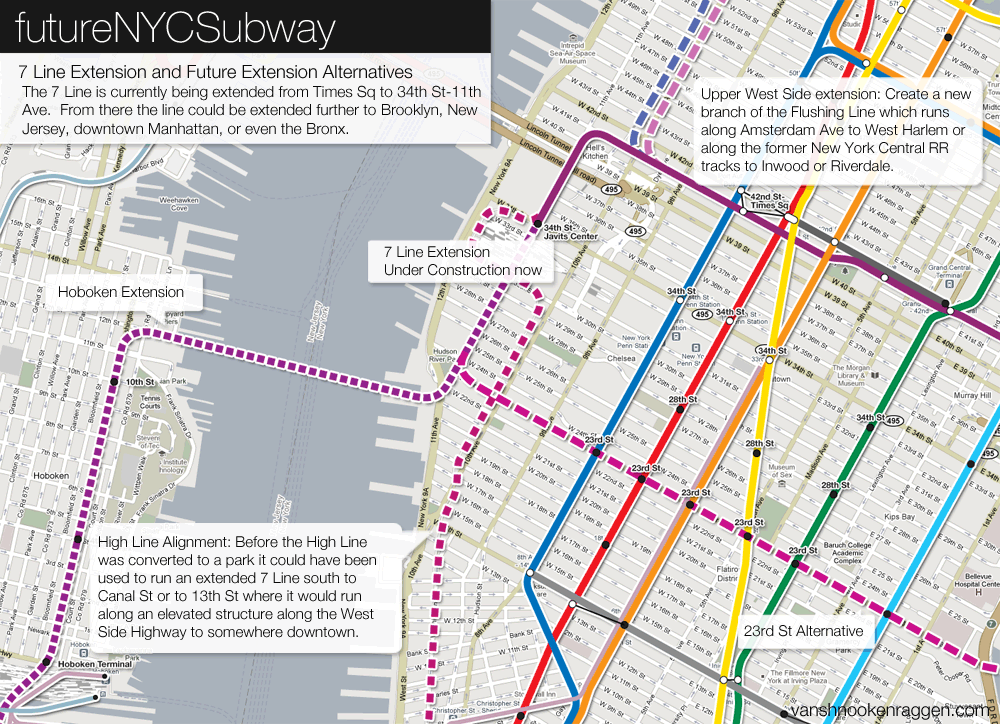
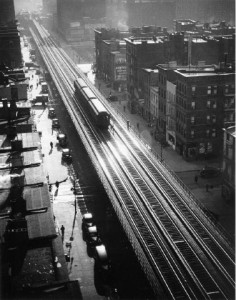

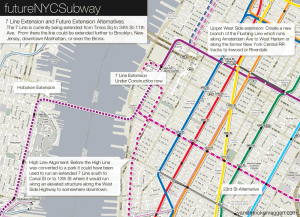
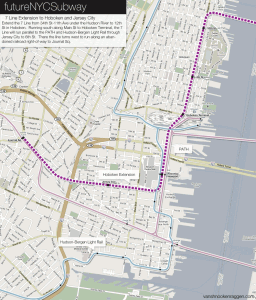
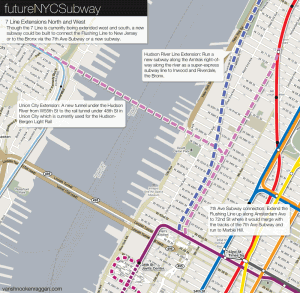
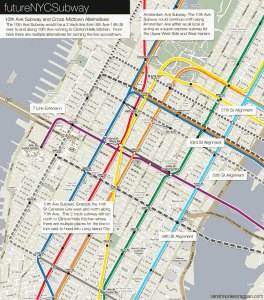
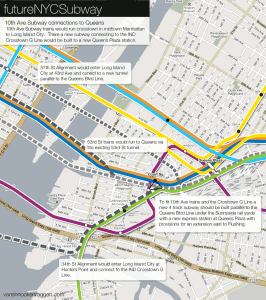
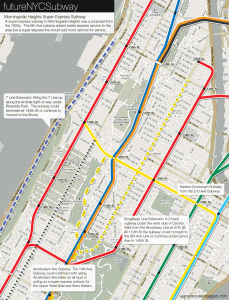
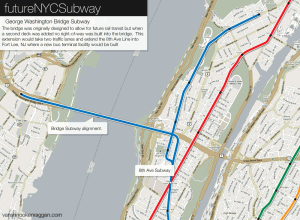
good idea. Manhattan does need an additional cross town line. 125st will greatly benefit Central Harlem. I personally think that the 50th street crosstown line will be of great benifit to Central Manhattan. The 50th street line could possibly travel towards 10 ave and end at 14st/10ave, while the L train could travel up 10 ave with stops at 23 st, 34 st, 42 st, 48st, 57st a super express continuing up 10/Amsterdam aves up to 125st, 135st, 145st, 155st, terminating at Washington Hts/168st, with connections to the 1, A and C trains! As for the T train. it could travel under the 50th st tunnel towards LIC Queens, 1st stop being Vernon Blvd, possibly turning north on 21st st up towards Ditmars Blvd, turning east onto Ditmars Blvd, onto Astoria Blvd, towards Citifield, onto Northern Blvd all the way to Little neck Pkwy queens!
A lot of interesting ideas. The main obstacle is the political will.
The feds want to spend billions on infrastructure, well were’re waiting!
People forget that the original IRT subway was built in 4 years; over 100 years ago.
At about the same time, the Penn Central Railroad constructed a tunnel across the Hudson River, the width of Manhattan at 34th St., then across the East River to its yards in Sunnyside. In addition to the tunnel and yards, it built Penn Station, The Hotel Pennsylvania, and the Hell Gate Rail Bridge…with private capital and in less time than it’s taking to rebuild the World Trade Center!
Cities over the world that were crushed during World War II (Tokyo, London, Berlin)
have rebuilt and expanded their systems. The all-but-political capitol of the victor(NYC)
has done virtually nothing since the end of the war. It’s a sad disgrace.
The tunneling technology is there; the country has the funds; I hope our leaders find the will.
I couldn’t agree more.
Great research on your part. Personally, I favor the 7 line extension thru Union City and linking/recreating the HBLR, the BSA (Bridge Subway Alignment) over the GWB & connecting to a new Bus Terminal in Fort Lee, the westside MNRR route along the Amtrak lines, and 14th St L train loop around Midtown Manhattan.
Wow. Alot of work went into this. I have been going over this for months and wanted to know about a few pointers that you have brought up. 1. Who owns the St marys tunnel that you plan to use for your X train? I have alot more, but I figured I’d ask something that stood out. Thanks again. I hate the mta, the red tape will never get anything done and no one will ever be responsible for it. Thanks again
I honestly don’t know. The city perhaps, but I figure it is so far off that it doesn’t really matter.
In your ideas posted, why not also extend the 7 to battery park? Or have it turn into a crossstown line at 23rd?
I don’t think the Lower West Side will ever need the extra service and I feel that turning the & train back into Brooklyn via 23rd St would just not fit into the overall plan I’ve laid out.
Just want to pass along a little thanks for post this little blog on the future of city subway expansion. I would like to say, that one of your ideas, which is the extension of the 7 line into NJ, may one day become a reality.
Check out the news report from New York 1 News at the link below.
http://www.ny1.com/content/top_stories/129069/city-floats-idea-of-extending-7-train-to-jersey
Good luck
For the flushing line westward and eastward extension, you can kill three birds with one stone by adding the numbers 8 & 9 as an additional service since they are not in use and they can operate at all times much like the 7 train
I love your ideas! They are really cool and creative! Yet as said in another comment IRT was built over 100 years ago and as it’s latest project on IRT was the Lenox Terminal Station there could be an expansion from there! Nobody has ever thought of it but the (3) could run through the far west Bronx by making a tight 7 street curve to the (B) and (D) under the Macombs Dam Bridge to serve residents of Morris Heights and can also serve lots of Yankees Fans after a game via University Avenue and Odgen Avenue south of 170th Street. The line could run to 195th Street and University Avenue so that it’s inbetween Kingbridge Road and Bedford Park Boulevard since it could give commuters from nearby Lehman College easier access to the Upper west side and Lincoln Center
IAM BEEN LOOKING FOR INMAGES OF THE BMT LINE RR CROSSING OVER THE 59th STREET BRIDGE FORA YEAR AND HAVE YET SEEN ANY INMAGES OF THAT?
I have not but I’ll keep an eye out for it.